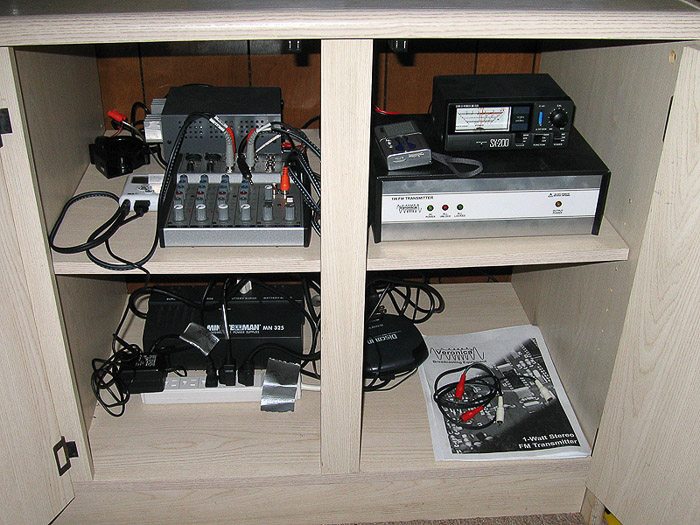Steve Rowell
KDRS
2005-08 / 2012-?
An unmanned low power FM radio station, installed in the Center for Land Use Interpretation's Desert Research Station (DRS) which transmitted from 2005-2008 and again from 2012-present. KDRS broadcasts a looping program indefinitely to the void of the Mojave Desert, the only audience being the chance person driving down the little used road in front of the DRS or the infrequent visitor or resident on site, aware of it. Over the years, at irregular intervals, I've changed the program. Recordings of sonic booms from my Sonic Boom Archive project (also conducted on this site) have been part of this program.

2005 CLUI Lay of the Land Newsletter article
Most recent playlist
KDRS CLUI DRS, Hinkley, CA
May 2005 - 2008; 2012 - present
Current program
June 2015 - present
Total program time: 4 hours, 46 minutes
Looping day and night, indefinitely
Track title ––– hh:mm:ss ––– Artist, Date
KDRS radio tones_mixdown ––– 47:34 ––– Steven Rowell, 2015
Ad Inexplorata / Toward the Unexplored ––– 24:34 ––– Edwards AFB, 1963
Nellis AFB Range scanner audio ––– 9:58 ––– Unknown radio scanner, unknown date
Nevada Test and Training Range ––– 1:10:32 ––– Unknown radio scanner, unknown date
The Shipping Forecast received at sea ––– 5:14 ––– BBC Radio 4, 2008
China Lake Naval Air Warfare Range Tour ––– 10:38 China Lake NAWR, unknown date
Remote Hams mix ––– 2:32 ––– Unknown ham operator, unknown date
Tom Nathan (1966) ––– 30:51 ––– KILE Radio Galveston, 1966
Nellis Red Flag March 2012 ––– 39:16 ––– Unknown radio scanner, 2012
Bill Young (1966) ––– 15:05 ––– KILT 610 Houston, 1966
The Shipping Forecast received on land ––– 5:14 ––– BBC Radio 4, 2015
Roy Storey's Sports Line #2 ––– 3:18 ––– Negativland, 1990
Part of this program, “Ad Inexporata / Toward the Unexplored”:
An earlier program featuring radio noises, tones, signals, and glitches, which looped for most of 2006:
The only way to get online except for satellite out there in the remote wastes:
Testing the first internet dial-up connection at the DRS in 2005. The very first broadcast of KDRS was done by downloading an audio file from the internet – the inaugural Long Now Foundation lecture by Brian Eno in 2003 (or as they say 02003) – using this connection. The one hour lecture took over 12 hours to download and was left to broadcast for one full year as a continuous, droning loop. The lecture was recorded with only one microphone in a very large lecture hall; the subtle distortions introduced by transmitting this audio through the desert atmosphere rendered Eno's voice almost entirely unintelligible and, appropriately, ambient as if the signal itself was somehow sent by an unknown source from a distant future Earth. In addition to this being broadcasted, I installed a small speaker near the front door of the DRS (to the left of the chair, in the video clip above) so that anyone visiting this remote, seemingly abandoned research station, day or night, would faintly hear the murmuring voice in what sounded like a cavernous hall many times larger than the actual structure itself.


